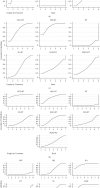Comparative Effectiveness and Safety of Seven Qi-Tonifying Chinese Medicine Injections for AECOPD Patients: A Systematic Review and Network Meta-Analysis
- PMID: 34819982
- PMCID: PMC8608497
- DOI: 10.1155/2021/6517515
Comparative Effectiveness and Safety of Seven Qi-Tonifying Chinese Medicine Injections for AECOPD Patients: A Systematic Review and Network Meta-Analysis
Abstract
Introduction: Acute exacerbation of chronic obstructive pulmonary disease (AECOPD) imposes a large burden on economy and society worldwide. In addition to western medicine, multiple kinds of qi-tonifying Chinese medicine injections have been widely used in China as adjunctive treatments. Previous small-sample clinical trials have proven their efficacy in the treatment of AECOPD. However, data on comparative effectiveness and safety of qi-tonifying injections are limited. We conducted this network meta-analysis to compare the efficacy and safety of 7 commonly used qi-tonifying injections in patients with AECOPD.
Methods: Literature search was conducted through electronic databases, including PubMed, the Cochrane Library, EMBASE, CINAHL, AMED, CBM, CNKI, Wanfang database, and VIP database. Randomized clinical trials (RCTs) exploring the efficacy of any of these 7 qi-tonifying injections were included. The primary outcome was lung function (FEV1 and FVC). R 4.0.0 and STATA 12.0 were adopted to perform the network meta-analysis using Bayesian statistics.
Results: A total of 36 RCTs involving 2657 participants were included. The results of network meta-analyses indicated that Chuankezhi injection (CKZ) combined with routine treatment (RT) was superior to other qi-tonifying injections combined with RT in terms of FEV1 improvement (MD = 0.63, 95% CI: 0.22, 1.04). For improving FVC, Shengmai injection (SGM) combined with RT showed the greatest therapeutic effect (MD = 0.38, 95% CI: 0.13, 0.61). Moreover, SGM combined with RT revealed the best estimates for response rate (MD = 4.00, 95% CI: 1.34, 13.63). The main adverse events in this study were gastrointestinal reactions and injection site reactions. No serious adverse events were reported.
Conclusion: In this network meta-analysis, SGM and CKZ were potential best adjunctive therapies in the treatment of AECOPD.
Copyright © 2021 Xueyi Deng et al.
Conflict of interest statement
All authors declare that they have no conflicts of interest.
Figures





References
-
- https://www.who.int/respiratory/copd/burden/en/, accessed 29 Jan 2020.
-
- World Health Organization. The top 10 causes of death. 2018. https://www.who.int/data/gho/data/themes/topics/causes-of-death .
-
- Eisner M. D., Anthonisen N., Coultas D., et al. An official American Thoracic Society public policy statement: novel risk factors and the global burden of chronic obstructive pulmonary disease. American Journal of Respiratory and Critical Care Medicine . 2010;182(5):693–718. doi: 10.1164/rccm.200811-1757st. - DOI - PubMed
-
- Anne G. Wheaton, division of population health, national center for chronic disease prevention and health promotion, CDC; laura kurth, respiratory health division, national institute for occupational safety and health, CDC. Morbidity and Mortality Weekly Report . 2019;68(13):303–307. - PubMed
Publication types
LinkOut - more resources
Full Text Sources

